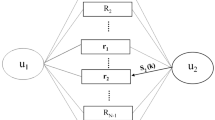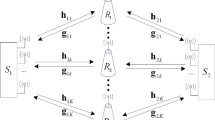Abstract
In this paper, we focus on studying the optimal joint relay positioning and power allocation for two serial relays’ transmission. We consider that information exchanges in Rayleigh flat-fading channels between two end-users which have symmetric traffic requirements in terms of the data rate. Multiple serial half-duplex relay nodes are employed to extend the communication coverage and assist the bidirectional communication between two end-users using the analog network coding protocol. With the objective of minimizing the total transmitting energy at the required data rate c, we investigate the optimal relay positioning and power allocation and then propose sub-optimal solutions for a two-serial-relay one-way channel and a two-serial-relay two-way channel due to no close-form optimal solution. Simulation results demonstrate a consistency with our proposed schemes.









Similar content being viewed by others
References
Cover, T. M., & El Gamal, A. A. (1979). Capacity theorems for the relay channel. IEEE Transactions on Information Theory, 25(5), 572–584.
Parkvall, S., Dahlman, E., Furuskar, A., Jading, Y., Olsson, M., Wanstedt, S., & Zangi, K. (2008). LTE-advanced- evolving LTE towards IMT-advanced. In Proceedings of th IEEE VTC, pp. 1–5.
Soldani, D., & Dixit, S. (2008). Wireless relays for broadband access [radio communications series]. Communications Magazine, IEEE, 46(3), 58–66.
Zhou, M., Cui, Q., Valkama, M., & Tao, X. (2012). Energy-efficient resource allocation for OFDMA-based two-way relay channel with physical-layer network coding. EURASIP Journal on Wireless Communications and Networking, 2012(66), 1–11.
Li, Y., Vucetic, B., Zhou, Z., & Dohler, M. (2007). Distributed adaptive power allocation for wireless relay networks. IEEE Transactions on Wireless Communications, 6(3), 948–958.
Chen, M., Serbetli, S., & Yener, A. (2008). Distributed power allocation strategies for parallel relay networks. IEEE Transactions on Wireless Communications, 7(2), 552–561.
Hasna, M.O., & Alouini, M.S. (2004). Optimal power allocation for relayed transmissions over Rayleigh-fading channels. IEEE Transactions on Wireless Communications, 3(6), 1999–2004.
Host-Madsen, A., & Zhang, J. (2005). Capacity bounds and power allocation for wireless relay channels. IEEE Transactions on Information Theory, 51(6), 2020–2040.
Zhang, X., & Gong, Y. (2009). Joint power allocation and relay positioning in multi-relay cooperative systems. Communications IET, 3(10), 1683–1692.
Lu, Y., Wang, D., & Fattouch, M. (2014). Novel spectrum sensing scheme in cognitive radio by simultaneously sensing/transmitting at full-duplex Tx and BER measurements at Rx. In Proceedings of the IEEE PIMRC, pp. 1–5.
Shannon, C.E. (1961). Two-way communication channels. In Proceedings of the 4th Berkeley symposium mathematical statistics probability, pp. 611–644.
Zhou, M., Cui, Q., Jntti, R., & Tao, X. (2012). Energy-efficient relay selection and power allocation for two-way relay channel with anolog network coding. Communications Letters, IEEE, 16(6), 816–819.
Li, Y., Zhang, X., Peng, M., & Wang, W. (2011). Power provisioning and relay positioning for two-way relay channel with analog network coding. Signal Processing Letters, IEEE, 18(9), 517–520.
Dohler, M., Gkelias, A., & Aghvami, H. (2004). Resource allocation for FDMA-based regenerative multihop links. EEE Transactions on Wireless Communications, 3(6), 1989–1993.
Luenberger, D. G., & Ye, Y. (2009). Linear and nonlinear programming . New York: Springer.
Acknowledgments
This work is financially supported by NSFC No. 61071214.
Author information
Authors and Affiliations
Corresponding author
Appendices
Optimal Relay Positioning and Power Allocation in One-Way One-Relay Transmission
In one-way transmission between \(R_1\) and \(S_2\) via \(R_2\), the optimization problem on relay positioning and power allocation can be expressed as
Applying KKT conditions into (40), its solution can be obtained as
Therefore,
Let \(\frac{\partial \xi 1_{min}}{\partial d_2}=0\), it is concluded that
By substituting (43) into (41), the transmit power becomes
And the corresponding transmit power at \(R_1, R_2\) and \(S_2\) is respectively obtained as
and
Optimal Relay Positioning and Power Allocation in Two-Way One-Relay Transmission
In two-way data transmission between \(R_1\) and \(S_2\) via \(R_2\), the optimization problem on relay positioning and power allocation can be expressed as
Applying KKT conditions into (46), its solution can be obtained as
Therefore,
Let \(\frac{\partial \xi 3_{min}}{\partial d_2}=0\), it is concluded that
By substituting (49) into (47), the transmit power becomes
And the corresponding transmit power at \(R_1, R_2\) and \(S_2\) is respectively obtained as
and
Rights and permissions
About this article
Cite this article
Zhou, J., Zhu, C., Wang, D. et al. Energy Efficient Relay Positioning and Power Allocation for Multi-Relay Symmetric Channel with Analog Network Coding. Wireless Pers Commun 84, 2735–2755 (2015). https://doi.org/10.1007/s11277-015-2764-9
Published:
Issue Date:
DOI: https://doi.org/10.1007/s11277-015-2764-9




